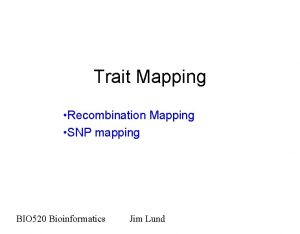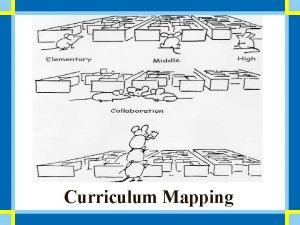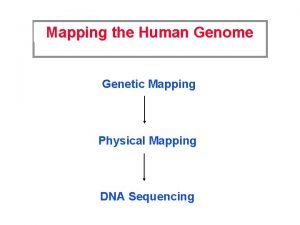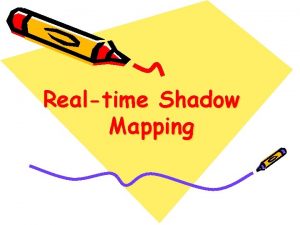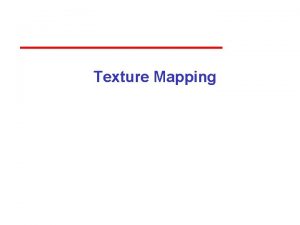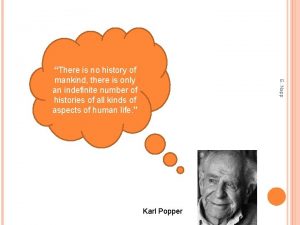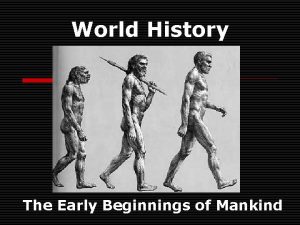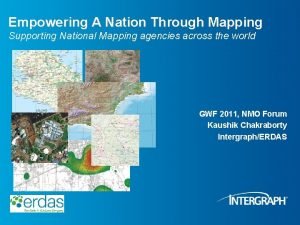Mapping through History of Mankind Few Glimpses Week



























- Slides: 27

Mapping through History of Mankind Few Glimpses Week 2 February 24, 2016 Department of RS and GISc Institute of Space Technology, Karachi

Spatial Information is all about Where is What? Map were conventionally used to answer this question!

› The first route map showing the whole of the Roman world (366– 335 B. C. )

PRE-GIS ERA • The tools used were pens, rulers, planimeters, dot grids, and paper sheets • Historical use of map was for navigation to know the location of physical features

▫ First printed Atlas of the world by legendary Roman geographer Claudius Ptolemy (150 A. D. ) ▫ Map projections of a spherical earth and use of latitude and longitude to characterize position Claudius Ptolemy (Alexandria, Egypt) (north arrow notation)

› Contour maps showing curves of equal value: an isogonic map, lines of equal magnetic declination for the world, (Edmond Halley, England) (1701) › Geological map (distribution of soils, minerals)- Johann Friedrich von Charpentier, Germany (1778) › Maps of the Battle of Yorktown (American Revolution) drawn by the French Cartographer Louis-Alexandre Berthier contained hinged overlays to show troop movements (1781)

▫ Statistical map of production in Europe, possibly the first economic and thematic map (shows geographic distribution of 56 commodities produced in Europe)- August Friedrich Wilhelm Crome , Germany (1782) ▫ First topographical map- Marcellin du Carla. Boniface , France (1782)

▫ First maps of the incidence of disease (yellow fever), using dots and circles to show individual occurrences in waterfront areas of New York by Valentine Seaman (1798)

› The first large-scale geological map of England Wales (William Smith, England) (1801) › First graph of isotherms, showing mean temperature around the world by latitude and longitude (Alexander von Humboldt Germany) (1817)

› Map with shadings from black to white (distribution and intensity of illiteracy in France), the first choropleth map, and perhaps the first modern statistical map (Pierre Charles Dupin, France). (1819) A choropleth map is a thematic map in which areas are shaded or patterned in proportion to the measurement of the statistical variable being displayed on the map

Choropleth Map • Map which shows regions or areas which have the same characteristics • 0, 1, 2 = light shade • 3, 4, 5 = Medium shade • 6, 7, 8 = Dark shade

▫ First simple dot map of population, 1 dot = 10, 000 people— Armand Joseph Fr`ere de Montizon – France (1830)

First published flow maps (Henry Drury Harness, Ireland) (1837) • showing transportation by means of shaded lines • widths proportional to amount (passengers)

▫ Dr. John Snow mapped cholera deaths in London and used geographical analysis to trace the outbreak to a contaminated well (dot map to display epidemiological data)- 1854 (or 1855)

▫ Pictogram, used to represent data by icons proportional to a number- Michael George Mulhall , England (1884)

Pictogram

▫ Street maps of London, showing poverty and wealth by color coding - Charles Booth (1889) BLACK: Lowest class. Vicious, semi-criminal. DARK BLUE: Very poor, casual. Chronic want. LIGHT BLUE: Poor. 18 shillings. to 21 s. a week for a moderate family PURPLE: Mixed. Some comfortable others poor PINK: Fairly comfortable. Good ordinary earnings. RED: Middle class. Well-to-do. YELLOW: Upper-middle and Upper classes. Wealthy

GIS BIRTH – Late 1960 s - start of quantitative decision making and widespread use of mathematical modeling Analysis of mapped data is a new perspective Map utilization from physical description of geographic space to new geospatial concepts and tools › interpreting mapped data › combining map layers › spatially characterizing and communicating complex spatial relationships

• Computational power of computers provided the ▫ means for efficient handling of voluminous data and ▫ effective spatial analysis capabilities • Emergence of GIS = maps from images to ‘Mapped Data’

Beginning Years – 1970 s • Beginning of Digital Mapping ▫ Map editing becomes easy in computer mapping ▫ Updates of resource maps can be done very quickly

Adolescent Years– 1980 s • Development of Spatial Database Management Systems ▫ Mapping capabilities of computer linked with traditional database management capabilities • It became possible to: ▫ Retrieve information about map location ▫ Retrieve/select location given specific set of conditions

• Improvement in digitizing equipment - manual digitizing tablets to automated scanners • Insurance of compatibility among systems addressed for digital maps by several sectors • Initiative on data standardization, decreased redundancy, and data sharing • Map encoding and database design emerged as an industry

Maturing Years– 1990 s • Map analysis and Modeling- from descriptive query to prescriptive analysis of maps • Modern GIS packages combine traditional mathematical capabilities with an extensive set of advanced map processing operations

GIS Today and Future • Primary use of GIS is same (manage, and analyze data, and communicate information) • Implementation technology evolving • Broader application areas • Broad adoption of GIS – at everyone's desk, PDA, cell phone, etc.

• Next generation satellites • High resolution satellite RS, high storage capacity, super high capacity network, real time data availability and display (continuous sensor derived data at web portal), future predictive modeling display • New application areas: GIS as methodology for the analysis on spheres* ▫ Other planets ▫ Human brain * Ron Briggs UT Dallas, 2007

• From 2 -D map display to 3 -D visualization to 4 D incorporation of time to 5, 6, 7 -D incorporation of touch, sound and smell

Reference • http: //www. gisdevelopment. net/history/index. htm • http: //www. innovativegis. com/basis/Map. Analysis/Topi c 27/Topic 27. htm#Early • http: //mama. indstate. edu/users/gejdg/447 wk 2. pdf • Milestones in the history of thematic cartography, statistical graphics, and data visualization by Michael Friendly August 24, 2009: http: //www. math. yorku. ca/SCS/Gallery/milestone/mile stone. pdf • Most of the slides are taken from Prof. Maria Antonia Brovelli’s lecture notes.
 Little and few
Little and few No bird soars too high essay
No bird soars too high essay Glimpses of god
Glimpses of god Leghnas
Leghnas Few ja a few ero
Few ja a few ero Few, a few, little, a little exercise
Few, a few, little, a little exercise Complete the sentences use these words
Complete the sentences use these words Week by week plans for documenting children's development
Week by week plans for documenting children's development The associative mapping is costlier than direct mapping.
The associative mapping is costlier than direct mapping. Forward mapping vs backward mapping
Forward mapping vs backward mapping Terjemahan
Terjemahan Halfway through the week
Halfway through the week Hsieh ho merged six cannons
Hsieh ho merged six cannons Satire against reason and mankind
Satire against reason and mankind A satyr against reason and mankind analysis
A satyr against reason and mankind analysis The creations of mankind
The creations of mankind Destruction of mankind
Destruction of mankind Destruction of mankind
Destruction of mankind Mankind should love nature
Mankind should love nature Mankind disp
Mankind disp Mystique adjective
Mystique adjective Mankind was naught by a single nation
Mankind was naught by a single nation How the world and mankind were created
How the world and mankind were created Mankind serving life
Mankind serving life Mankind loughborough
Mankind loughborough Through one man
Through one man Furcation classification
Furcation classification Advantage of through and through sawing
Advantage of through and through sawing






























